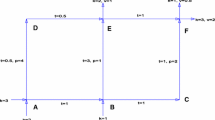Abstract
In the literature, several studies have algebraically characterized the set of toll vectors or patterns that, when added to a user equilibrium problem, its solution would be system optimal. Toll vectors in this set are termed “valid.” While the toll vector commonly advocated in the literature, i.e., one that equates the toll on each link to its marginal external cost, is always valid, other valid toll vectors generally exist and many leave some utilized links in the network untolled. On the surface, this may appear unreasonable and seems to violate the principle of marginal-cost pricing. This note shows that, when travel demands are elastic, all valid toll vectors satisfy this principle, in that the total tolls for each path equals the congestion externality an additional traveler on the path imposes on others.
Similar content being viewed by others
References
Arnott, R., & Small, K. (1994). The economics of traffic congestion. American Scientists, 82, 447–455.
Bai, L. H., Hearn, D. W., & Lawphongpanich, S. (2004). Decomposition techniques for the minimum toll revenue problem. Networks, 44(2), 142–150.
Bai, L. H., Hearn, D. W., & Lawphongpanich, S. (2006). Relaxed toll sets for congestion pricing problems. In S. Lawphongpanich, D. W. Hearn, M. J. Smith (Eds.), Mathematical and computational models for congestion charging (pp 23–44). New York: Springer.
Bergendorff, P. (1995). The bounded flow approach to congestion pricing. Sweden: Master’s thesis, Division of Optimization and Systems Theory, Department of Mathematics, Royal Institute of Technology, Stockholm.
Bergendorff, P., Hearn, D. W., & Ramana, M. V. (1997). Congestion toll pricing of traffic networks. In P. Pardalos, D. W. Hearn, W. W. Hager (Eds.), Network optimization, lecture notes in economics and mathematical systems (Vol. 450, pp. 51–71). New York: Springer.
Button, K. J. (1993). Transport economics. Northampton: Edward Elgar.
Hearn, D. W., & Ramana, M. V. (1998). Solving congestion toll pricing models. In P. Marcotte, S. Nguyen (Eds.), Equilibrium and advanced transportation models (pp. 109–124). Norwell: Kluwer Academic.
Hearn, D. W., Yildirim, M. B., Ramana, M. V., & Bai, L. H. (2001). Computational methods for congestion toll pricing models. In Proceedings of the 2001 IEEE intelligent transportation systems conference, Oakland, California, 25–29 August.
Hearn, D. W., & Yildirim, M. B. (2002). A toll pricing framework for traffic assignment problems with elastic demand. In M. Gendreau, P. Marcotte (Eds.), Transportation and network analysis: Current trends, (pp 135–145). Norwell: Kluwer Academic.
Larsson, T., & Patriksson, M. (1998). Side constrained traffic equilibrium models-traffic management through link tolls. In P. Marcotte, S. Nguyen (Eds.), Equilibrium and advanced transportation modeling (pp. 125–151). Norwell: Kluwer Academic.
Lindsey, R. (2006). Do economists reach a conclusion on road pricing? The intellectual history of an idea. Economic Journal Watch, 3, 292–379.
Lindsey, R., & Verhoef, E. (2001). Traffic congestion and congestion pricing. In K. J. Button, D. A. Hensher (Eds.), Handbook of transport systems and traffic control (pp. 77–105). Oxford: Pergamon.
Penchina, C. M. (2002). Flexibility of tolls for optimal flows in networks with fixed and elastic demands. In Proceedings of the transportation research board 81st annual meeting. Paper # TRB 02-2721, Washington, D.C.
Pigou, A.C. (1920). The economics of welfare. New York: MacMillan.
Tsekeris, T., & Voss, S. (2009). Design and evaluation of road pricing: State-of-the-art and methodological advances. Netnomics: Economic Research and Electronic Networking. doi:https://doi.org/10.1007/s11066-008-9024-z.
Vickrey, W. S. (1963). Pricing in urban and suburban transport. American Economic Review, 53, 452–465.
Yang, H., & Huang, H.-J. (1998). Principle of marginal-cost pricing: How does it work in a general road network. Transportation Research, 32, Part A, 45–54.
Author information
Authors and Affiliations
Corresponding author
Rights and permissions
About this article
Cite this article
Yin, Y., Lawphongpanich, S. Alternative marginal-cost pricing for road networks. Netnomics 10, 77–83 (2009). https://doi.org/10.1007/s11066-008-9020-3
Received:
Accepted:
Published:
Issue Date:
DOI: https://doi.org/10.1007/s11066-008-9020-3




